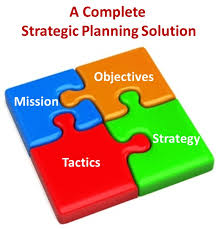 I believe there is a misconception out there about strategic planning because I keep running into executive directors who think just because the current plan is expiring that is must be time to begin work on a new strategic plan. I also oftentimes run into folks who believe it is a perfect time to start planning when their agency is experiencing instability, blurriness, and confusion. In my humble opinion, there is a time and place for strategic planning and embarking on this journey at the wrong time can be at best frustrating and at worst damaging.
I believe there is a misconception out there about strategic planning because I keep running into executive directors who think just because the current plan is expiring that is must be time to begin work on a new strategic plan. I also oftentimes run into folks who believe it is a perfect time to start planning when their agency is experiencing instability, blurriness, and confusion. In my humble opinion, there is a time and place for strategic planning and embarking on this journey at the wrong time can be at best frustrating and at worst damaging.
Readiness questions
Just the other day, I was talking with a friend about this issue, and they asked the obvious question, “How do you know when the conditions are right?” I started off saying something stupid like: “You’ll know when the time is right.” I knew it was dumb advice as it was coming out of my mouth.
So, I went home and started digging through my library of planning materials. I came across an old strategic planning document from a previous employer who had partnered with BoardSource to create the manual. So, you know it is good stuff. 😉
 As I had hoped, I found a section titled “Key Questions to Assess Readiness and Capacity”. Here are those questions:
As I had hoped, I found a section titled “Key Questions to Assess Readiness and Capacity”. Here are those questions:
- Do your regular board meetings (apart from retreats) include at least one strategic, or “Big Picture,” issue on the agenda?
- Is your current strategic plan based on realistic and comprehensive assumptions about the agency and its external environment? What considerations are missing?
- How might changing demographics and other economic, social, and political trends affect a constituent, client, or membership base that provides a primary revenue stream?
- What goal should the agency strive to achieve for financial reserves (for example, at least one-half of the operating budget)? Are there some potential revenue streams to consider?
- Are new priorities clear and the proposed means of paying for them realistic? Which programs should be self-supporting? Which might be operated at a loss in order to fulfill the agency’s mission?
- What metrics do you use to monitor organizational effectiveness?
- Have you considered all the options and chosen a planning method (aka planning model) that works best for the agency? Are you flexible enough to combine approaches if that suits our culture?
- How do you include board members who are not on the planning committee as participants in the process?
- What performance measures should be included in your strategic plan?
- How do you keep our strategic plan active and visible within and outside the agency?
- How often do you conduct strategic planning? Does that cycle make sense for the agency?
- When you are ready to undertake a planning process, are you clear about why you are planning?
- Are you clear about the roles of the board, executive director, and staff in strategic planning? Do you honor the distinctions?
- Have you used consultants in the most effective ways possible? If you have never used a consultant, should you consider doing so?
I’m not thrilled with these questions because I think they blend together two different issues — capacity and readiness. So, if you’re just trying to decide whether or not your agency is ready to start down the strategic planning road, I suggest you and your board governance committee spend some time chewing on questions 7, 8, 11, 12, and 13.
The other questions are important, too. I just think the five question I just highlighted cut to the heart of the matter.
 We’re not ready, but we still need a plan!
We’re not ready, but we still need a plan!
If your board governance committee determines that you’re not ready, but you see difficulty down the road and think you need a plan to guide your efforts, you may not be out-of-luck.
You should look into developing a short-term tactical plan focused on the next 12 months.
Perhaps, a business plan or a something addressing a specific agency function (e.g. resource development, program, facilities, etc) might be a better use of time for you and your volunteers.
Did you mention consequences?
Earlier in this post I said, “. . . there is a time and place for strategic planning and embarking on this journey at the wrong time can be at best frustrating and at worst damaging.”
I been down this path many times, and I encourage you to please learn from my mistakes.
If you start down a strategic planning road when you aren’t ready to do so, I’ve seen the following things happen:
- It feels like you’re spinning your wheels, and you end up spending LOTS of time of stuff that you thought were obvious.
- Volunteers get frustrated. They feel like they’re going nowhere fast. Some even express that it is a waste of their time.
- I’ve seen board members resign in the middle of difficult strategic planning processes.
- I’ve seen major disagreements result in boardroom rifts.
- I’ve also seen executive directors get fired.
How has your agency determined readiness? Do you have other questions to add to the list? Please use the comment box below to share your thoughts and experiences. We can all learn from each other.
Here’s to your health!
Erik Anderson
Founder & President, The Healthy Non-Profit LLC
www.thehealthynonprofit.com
erik@thehealthynonprofit.com
http://twitter.com/#!/eanderson847
http://www.facebook.com/eanderson847
http://www.linkedin.com/in/erikanderson847

 Welcome to the final post in our five-part series on Governance. We have already discussed the Board’s role in
Welcome to the final post in our five-part series on Governance. We have already discussed the Board’s role in 



 Full discloser . . . I went out for a few glasses of wine on Tuesday night with a non-profit friend and got back home a little late at night. So what? Who cares? Well, I need to be up and on the road at 5:00 am to visit an out-of-state client, which means I needed to write my Wednesday blog post on Tuesday night. Oooops! So, I’m heading to bed in the next few minutes and wringing my hands about not writing something in the morning. Luckily, my friend said something provocative over a glass of wine and that will the be center of today’s post.
Full discloser . . . I went out for a few glasses of wine on Tuesday night with a non-profit friend and got back home a little late at night. So what? Who cares? Well, I need to be up and on the road at 5:00 am to visit an out-of-state client, which means I needed to write my Wednesday blog post on Tuesday night. Oooops! So, I’m heading to bed in the next few minutes and wringing my hands about not writing something in the morning. Luckily, my friend said something provocative over a glass of wine and that will the be center of today’s post. Welcome to O.D. Fridays at DonorDreams blog. Every Friday for the foreseeable future we will be looking at posts from John Greco’s blog called “
Welcome to O.D. Fridays at DonorDreams blog. Every Friday for the foreseeable future we will be looking at posts from John Greco’s blog called “ The point I’m trying to make is that most non-profit organizations have built a culture that revolves around THE CLIENT. This focal point is so intense that ideas threatening to shift that focus are often seen as heresy.
The point I’m trying to make is that most non-profit organizations have built a culture that revolves around THE CLIENT. This focal point is so intense that ideas threatening to shift that focus are often seen as heresy.
 You know what Douglas Adams says (according to
You know what Douglas Adams says (according to  When I look at my email inbox, I do a lot of scanning. I first look at the names of people who sent me something. As I do this, I am deleting anything that vaguely looks like spam or advertising. I don’t even open it. After this first purge, I re-visit those who are left standing and start looking at subject lines. I’m essentially trying to prioritize what I should open first versus leave for later when I have more time. And when I say “leave for later,” it could be days or weeks later.
When I look at my email inbox, I do a lot of scanning. I first look at the names of people who sent me something. As I do this, I am deleting anything that vaguely looks like spam or advertising. I don’t even open it. After this first purge, I re-visit those who are left standing and start looking at subject lines. I’m essentially trying to prioritize what I should open first versus leave for later when I have more time. And when I say “leave for later,” it could be days or weeks later. Welcome to O.D. Fridays at DonorDreams blog. Every Friday for the foreseeable future we will be looking at posts from John Greco’s blog called “
Welcome to O.D. Fridays at DonorDreams blog. Every Friday for the foreseeable future we will be looking at posts from John Greco’s blog called “ One of the pre-test questions that tends to trip people up is whether or not the board has a responsibility to “oversee the CEO“. Believe it or not, it isn’t uncommon for one-quarter to one-third of board volunteers to say “NO“.
One of the pre-test questions that tends to trip people up is whether or not the board has a responsibility to “oversee the CEO“. Believe it or not, it isn’t uncommon for one-quarter to one-third of board volunteers to say “NO“. So, maybe you don’t know where to start?
So, maybe you don’t know where to start? Welcome to O.D. Fridays at DonorDreams blog. Every Friday for the foreseeable future we will be looking at posts from John Greco’s blog called “
Welcome to O.D. Fridays at DonorDreams blog. Every Friday for the foreseeable future we will be looking at posts from John Greco’s blog called “ If I’ve seen it once, I’ve seen it hundreds of times. And I bet you have, too. I will omit the names to protect the innocent.
If I’ve seen it once, I’ve seen it hundreds of times. And I bet you have, too. I will omit the names to protect the innocent. We’ve also all seen this situation.
We’ve also all seen this situation. A non-profit organization that doesn’t invest time and resources into evaluation and critique is akin to an ostrich sticking its head in the sand.
A non-profit organization that doesn’t invest time and resources into evaluation and critique is akin to an ostrich sticking its head in the sand. Over the years, I’ve met non-profit board volunteers who didn’t see value or the need for staff. Likewise, I’ve met countless numbers of staff who complain about their board members. I’ve also met executive directors who deliberately do things to disengage their board volunteers (e.g. taking on fundraising responsibilities, reducing the number of board meetings, etc).
Over the years, I’ve met non-profit board volunteers who didn’t see value or the need for staff. Likewise, I’ve met countless numbers of staff who complain about their board members. I’ve also met executive directors who deliberately do things to disengage their board volunteers (e.g. taking on fundraising responsibilities, reducing the number of board meetings, etc). Welcome to O.D. Fridays at DonorDreams blog. Every Friday for the foreseeable future we will be looking at posts from John Greco’s blog called “
Welcome to O.D. Fridays at DonorDreams blog. Every Friday for the foreseeable future we will be looking at posts from John Greco’s blog called “ I find this distinction really fascinating, and I haven’t been able to stop thinking about it since I read this post. So, I’ve been focused on identifying some non-profit related “predicaments” and here is what I’ve come up with . . .
I find this distinction really fascinating, and I haven’t been able to stop thinking about it since I read this post. So, I’ve been focused on identifying some non-profit related “predicaments” and here is what I’ve come up with . . .